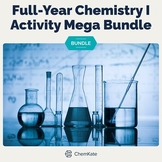Naming Ionic Compounds Stations Activity | Chemistry Intro Print and Digital
- PDF
- Google Apps™
- Internet Activities

What educators are saying
Also included in
- Included in this bundled are a wide variety of resources, from a naming flowchart for ionic, covalent & acidic formulas, an active ion compound making and naming activity with worksheets, and an active question trail. Some reasons are also available in digital verions.This Naming Bundle resourcePrice $23.59Original Price $29.49Save $5.90
- Teaching chemistry? Looking for a wide variety of engaging, low- to no-prep, digital, and easy-to-use activities to help you teach chemistry and your curriculum? Save 30% with this full year Chemistry I Activity Mega Bundle includes full of self-grading, self-checking activities, inquiry activities,Price $337.85Original Price $482.64Save $144.79
- This is a custom bundle, but you may purchase this custom bundle for yourself or request your own by emailing KateCk@ChemKate.com. Deeper discounts, anywhere from 20-30% off, are given based on the price range, email me for details.This custom bundle includes a sampling of year-long resources incluPrice $84.13Original Price $120.69Save $36.56
- This is a custom bundle, but you may purchase this custom bundle for yourself or request your own by emailing KateCk@ChemKate.com. Deeper discounts, anywhere from 20-30% off, are given based on the price range, email me for details.This custom bundle includes a sampling of year-long resources includPrice $16.80Original Price $21.00Save $4.20
Description
Looking for a no-prep activity to help your students understand the naming rules of ionic compounds? In print and digital, this introduction to binary ionic compound naming stations and accompanying handout lead students through examples of ionic compound names, guiding them to discover the patterns/rules of ionic compound nomenclature - for both Type I (one charge) and Type II (variable charge) cations with their anions. The digital self-grading version gives instant feedback to you and your students and can be modified to fit your needs.
Once complete, the student handout becomes the student's note page. These stations pair naturally with the Naming Flowchart. Great for collaborative work for groups of 2-3.
✦ This is available in the costs-savings ✦Naming Bundle✦ - Visit this bundle to see other great naming resources, such as an easy-to-follow flowchart, escape room and more. Save time and assurance with all the activities found in this Chemistry I MEGA Bundle - Visit this bundle to see a wide variety of guided inquiry activities, graphic organizers and digital practice and application ✦
Prior Student Knowledge:
- How to label the ion charges above groups 1, 2, 13 and 15-17.
- How to find the ions from an ionic compound formula (reverse "drop & swap" or reverse "criss-cross")
Interested in more?
Mole and Stoichiometry Resources
● Be sure to follow my store to be alerted of new products: CLICK HERE
● Did you know that you can receive credit towards future TpT purchases by reviewing this product? Please help my store grow by leaving a review at the product page or through "My Purchases" under "My Account" at TpT. I enjoy making products to help you be successful in the classroom, so if you have any other questions or suggestions, please contact me in the "Ask a Question" tab above.








